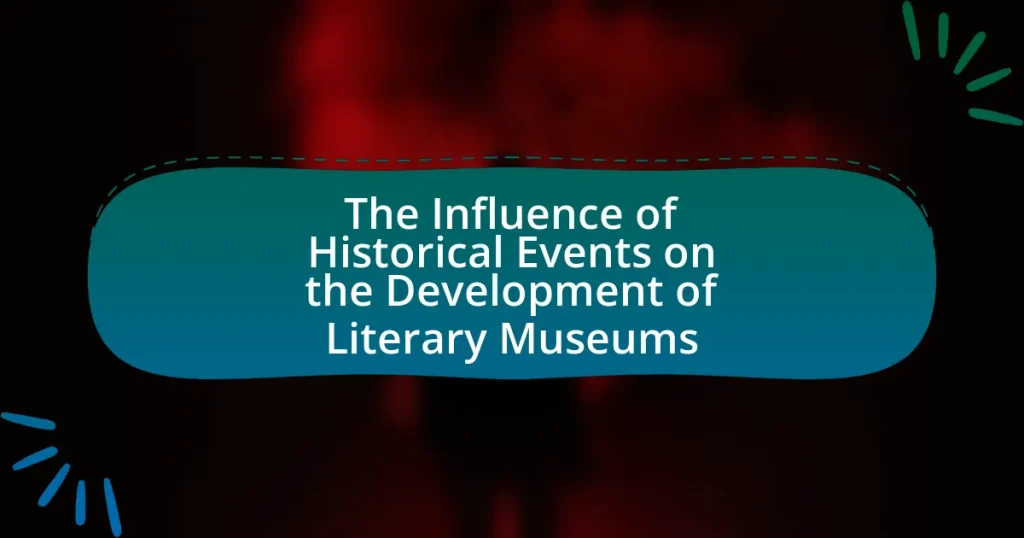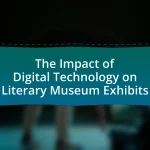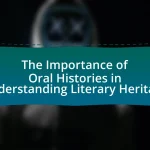The article examines the influence of historical events on the development of literary museums, highlighting how these events shape themes, collections, and public engagement strategies. It discusses significant historical movements, such as nationalism and modernism, and their impact on the establishment and focus of literary museums, including the celebration of national authors and the inclusion of diverse literary voices. The article also explores the role of contemporary social movements in shaping museum programming and the importance of studying historical influences to understand the narratives presented in literary museums. Key examples illustrate how museums adapt to reflect societal changes and enhance their educational value.
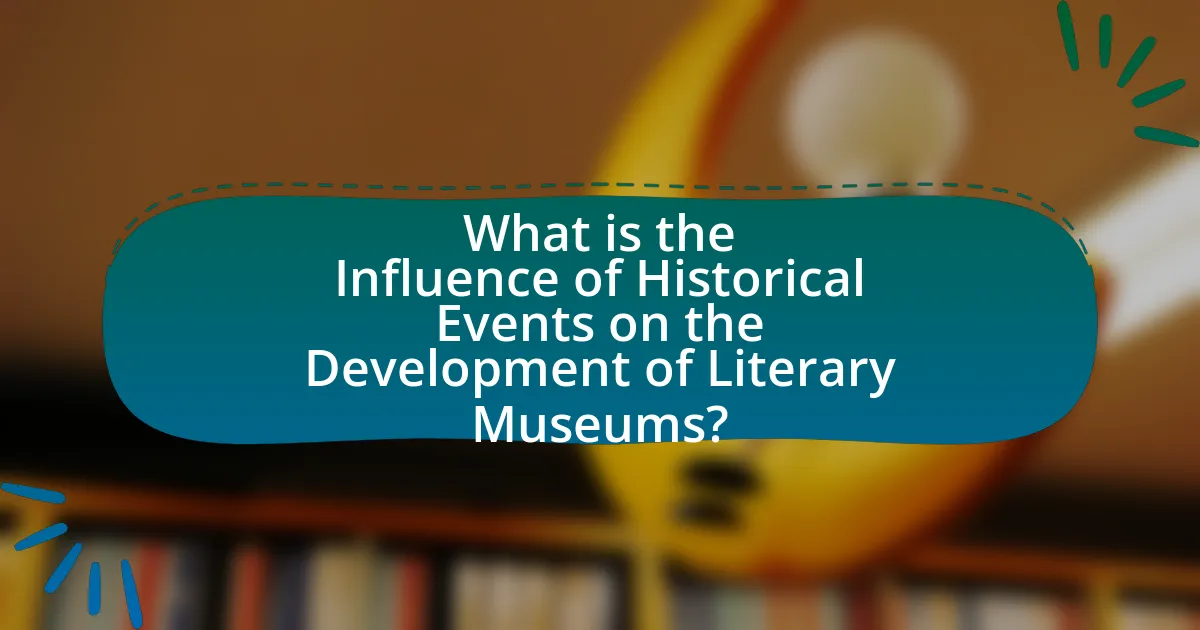
What is the Influence of Historical Events on the Development of Literary Museums?
Historical events significantly influence the development of literary museums by shaping their themes, collections, and public engagement strategies. For instance, the rise of nationalism in the 19th century led to the establishment of literary museums that celebrated national authors and their contributions, such as the establishment of the Charles Dickens Museum in London in 1925, which reflects the Victorian era’s cultural values. Additionally, major historical movements, such as the civil rights movement, have prompted museums to include diverse literary voices, as seen in the incorporation of African American literature in institutions like the Schomburg Center for Research in Black Culture. These developments illustrate how literary museums adapt to reflect societal changes and historical contexts, thereby enhancing their relevance and educational value.
How have significant historical events shaped the concept of literary museums?
Significant historical events have shaped the concept of literary museums by influencing their establishment, focus, and the narratives they present. For instance, the rise of nationalism in the 19th century led to the creation of museums that celebrated national literary figures, reflecting cultural pride and identity. The aftermath of World War II saw an increase in museums dedicated to preserving the works of authors who faced persecution, such as those in the Holocaust, emphasizing the role of literature in social justice and memory. Additionally, the digital revolution has transformed literary museums, allowing them to incorporate technology and reach broader audiences, thus adapting to contemporary cultural shifts. These historical contexts demonstrate how literary museums evolve in response to societal changes and historical significance.
What are some key historical events that influenced the establishment of literary museums?
Key historical events that influenced the establishment of literary museums include the rise of the Romantic movement in the late 18th and early 19th centuries, which emphasized individual authors and their contributions to literature. This period saw the creation of museums dedicated to authors like the Brontë sisters and William Wordsworth, reflecting a growing public interest in their lives and works. Additionally, the establishment of national literary societies in the 19th century, such as the American Antiquarian Society in 1812, provided a framework for preserving literary heritage. The centenary celebrations of famous authors, such as Charles Dickens in 1870, further spurred the creation of dedicated spaces to honor their legacies. These events collectively contributed to the recognition of literary figures as cultural icons, leading to the establishment of literary museums worldwide.
How did the cultural context of these events impact the development of literary museums?
The cultural context of historical events significantly influenced the development of literary museums by shaping public interest and funding for literary heritage. For instance, the rise of nationalism in the 19th century led to increased appreciation for national literature, prompting the establishment of museums dedicated to local authors and literary movements. This was evident in countries like France and Germany, where literary figures were celebrated as national icons, resulting in the creation of institutions that preserved their works and legacies. Additionally, the cultural movements of the 20th century, such as modernism and postmodernism, further encouraged the establishment of literary museums as spaces for critical engagement with literature, reflecting societal changes and diverse narratives. The establishment of the British Library in 1973, for example, was a direct response to the cultural need for a centralized repository of literary works, showcasing the impact of cultural context on the evolution of literary museums.
Why is it important to study the historical influences on literary museums?
Studying the historical influences on literary museums is important because it reveals how cultural, social, and political contexts shape the narratives and collections presented. Historical events, such as wars, movements, and literary trends, directly impact the formation and evolution of these institutions, influencing which authors and works are celebrated or marginalized. For instance, the establishment of the British Museum in 1753 was influenced by the Enlightenment, which emphasized knowledge and cultural preservation. Understanding these influences allows for a deeper appreciation of the museums’ roles in reflecting societal values and preserving literary heritage.
What insights can we gain about literature through the lens of historical events?
Literature reflects the socio-political and cultural contexts of its time, providing insights into the values, struggles, and experiences of different historical periods. For instance, the impact of World War I on literature is evident in the works of authors like Erich Maria Remarque and Virginia Woolf, who explored themes of disillusionment and trauma. Additionally, the Harlem Renaissance, a cultural movement in the 1920s, showcased the voices of African American writers, highlighting racial injustices and the quest for identity. These examples illustrate how historical events shape literary themes, styles, and movements, allowing readers to understand the complexities of human experience through the narratives produced during those times.
How do literary museums reflect the socio-political climate of their time?
Literary museums reflect the socio-political climate of their time by showcasing the works and lives of authors who respond to contemporary issues. These institutions often curate exhibits that highlight the political, social, and cultural contexts in which literary figures operated, thereby illustrating how literature serves as a mirror to societal values and conflicts. For example, the American Writers Museum in Chicago features exhibits on authors like Langston Hughes, whose work addressed racial inequality during the Harlem Renaissance, directly linking literary expression to the socio-political struggles of that era. Additionally, literary museums may include artifacts, manuscripts, and multimedia presentations that contextualize the authors’ responses to events such as wars, revolutions, and social movements, reinforcing the connection between literature and the prevailing socio-political climate.
What role do historical events play in the curation of literary museum exhibits?
Historical events significantly shape the curation of literary museum exhibits by providing context and relevance to the works displayed. Curators often select artifacts, manuscripts, and narratives that reflect the socio-political climate of specific periods, allowing visitors to understand the influence of events such as wars, revolutions, and cultural movements on literary production. For instance, the impact of World War I on modernist literature is often highlighted in exhibits, showcasing how the trauma and disillusionment of the era influenced authors like T.S. Eliot and Virginia Woolf. This contextualization not only enriches the visitor experience but also fosters a deeper appreciation of literature as a response to historical circumstances.
How do curators select artifacts that represent historical influences?
Curators select artifacts that represent historical influences by conducting thorough research on the cultural, social, and political contexts of the time periods they aim to represent. They analyze primary sources, such as documents and eyewitness accounts, to identify significant events and figures that shaped history. For instance, curators may focus on artifacts related to the American Civil War, selecting items like letters, uniforms, and personal belongings that illustrate the conflict’s impact on society. This selection process is often guided by established historical narratives and scholarly consensus, ensuring that the artifacts chosen accurately reflect the complexities of the era.
What narratives are constructed around historical events in literary museums?
Literary museums construct narratives that highlight the interplay between historical events and literary production. These narratives often focus on how specific events, such as wars, revolutions, or social movements, influence the themes, styles, and purposes of literary works. For instance, the impact of World War I on modernist literature is frequently showcased in literary museums, illustrating how the trauma and disillusionment of the era shaped writers like T.S. Eliot and Virginia Woolf. Additionally, literary museums may present biographical accounts of authors, linking their personal experiences during historical events to their literary output, thereby contextualizing their works within broader societal changes. This approach not only educates visitors about the historical context but also emphasizes the relevance of literature as a reflection of human experience during significant events.
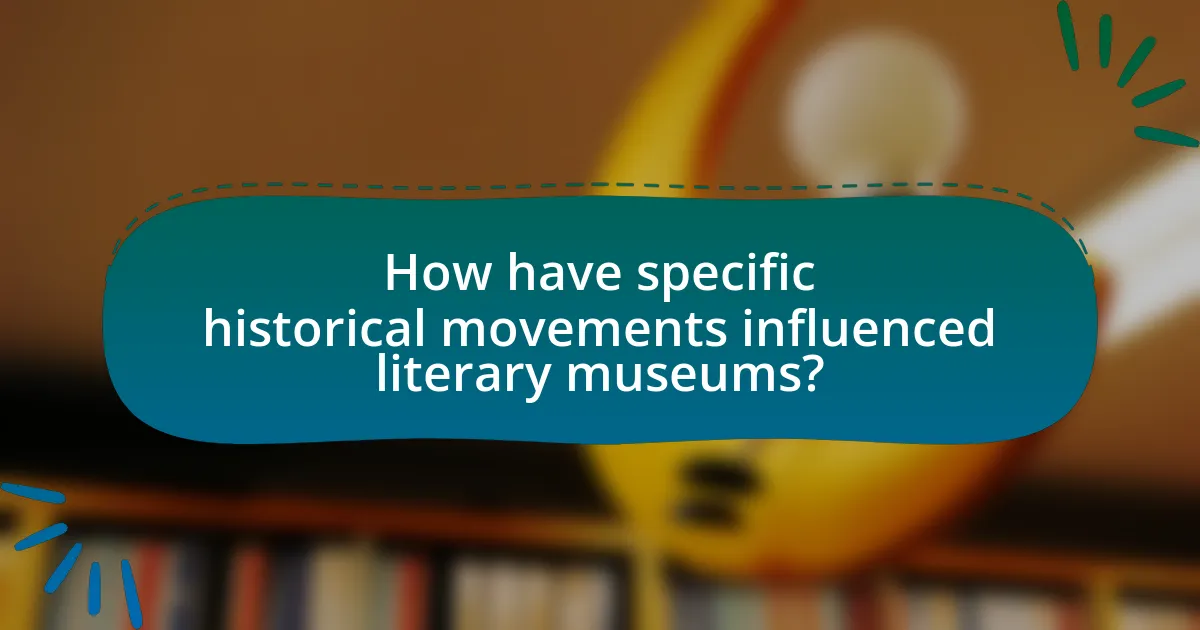
How have specific historical movements influenced literary museums?
Specific historical movements have significantly influenced literary museums by shaping their themes, collections, and educational missions. For instance, the Romantic movement in the late 18th and early 19th centuries emphasized individualism and emotional expression, leading to the establishment of museums dedicated to authors like William Wordsworth and Samuel Taylor Coleridge, which focus on their personal lives and creative processes. Additionally, the feminist movement has prompted the creation of literary museums that highlight women writers, such as the Brontë Parsonage Museum, which showcases the lives and works of the Brontë sisters, reflecting the broader societal changes regarding women’s roles in literature. Furthermore, post-colonial movements have influenced literary museums to include diverse voices and narratives, as seen in the establishment of the African American Museum of Literature, which aims to preserve and promote African American literary heritage. These movements have not only expanded the scope of literary museums but also transformed them into spaces for cultural dialogue and education.
What impact did the Romantic movement have on literary museums?
The Romantic movement significantly influenced literary museums by emphasizing the importance of individual authors and their emotional experiences. This shift led to the establishment of museums that focused on preserving the personal artifacts, manuscripts, and letters of writers, thereby creating a more intimate connection between the public and the literary figures. For instance, the establishment of the Wordsworth Museum in 1883 highlighted the Romantic ideal of celebrating the lives and works of poets, reflecting the movement’s focus on personal expression and the sublime. This trend encouraged the development of literary museums as spaces for both education and emotional engagement, fostering a deeper appreciation for literature and its creators.
How did the ideals of the Romantic movement shape museum collections?
The ideals of the Romantic movement significantly shaped museum collections by emphasizing individual expression, emotional depth, and the appreciation of nature and the sublime. This movement led to the inclusion of works that celebrated personal experience and the beauty of the natural world, reflecting the Romantic belief in the importance of the artist’s emotional connection to their subject. For instance, museums began to acquire and display artworks that depicted dramatic landscapes and intense human emotions, aligning with the Romantic focus on the subjective experience. Additionally, the Romantic movement encouraged the collection of artifacts that represented national identity and cultural heritage, as seen in the rise of national museums during the 19th century, which aimed to foster a sense of pride and connection to the past.
What specific authors or works from the Romantic period are highlighted in literary museums?
Literary museums prominently highlight authors such as William Wordsworth, Samuel Taylor Coleridge, and John Keats, along with their significant works like “Lyrical Ballads” and “Ode to a Nightingale.” These authors are central figures of the Romantic period, which is characterized by an emphasis on emotion, nature, and individualism. For instance, the Wordsworth Museum in the Lake District showcases manuscripts and personal artifacts related to Wordsworth and Coleridge, illustrating their contributions to Romantic literature. Similarly, the Keats-Shelley House in Rome features memorabilia that reflects the life and works of John Keats, emphasizing his impact on the Romantic movement.
How did the rise of modernism affect the development of literary museums?
The rise of modernism significantly influenced the development of literary museums by shifting the focus towards contemporary literature and the representation of diverse literary voices. This movement encouraged museums to curate exhibits that reflect modernist themes such as fragmentation, subjectivity, and the exploration of new narrative forms. For instance, the establishment of the Modern Literature Museum in 1970 showcased works from modernist authors like Virginia Woolf and James Joyce, emphasizing their impact on literary innovation. Additionally, modernism’s emphasis on the individual experience led museums to incorporate interactive and immersive exhibits, allowing visitors to engage with literature in a more personal and dynamic way. This evolution in museum practices illustrates how modernism reshaped the narrative and educational approaches within literary museums.
What changes in museum practices emerged during the modernist period?
During the modernist period, museum practices shifted towards a focus on the presentation of art as an experience rather than merely as objects for display. This transformation included the adoption of innovative exhibition techniques, such as thematic displays and immersive environments, which aimed to engage visitors on a deeper emotional and intellectual level. Additionally, modernist museums began to emphasize the importance of context, showcasing artworks within narratives that highlighted their cultural and historical significance. This approach was influenced by the broader modernist movement, which sought to break away from traditional forms and embrace new ideas, as seen in the works of artists and thinkers like Marcel Duchamp and Virginia Woolf. These changes reflect a significant evolution in how museums interacted with their audiences, prioritizing engagement and interpretation over mere collection and preservation.
How do literary museums today reflect modernist themes and authors?
Literary museums today reflect modernist themes and authors by showcasing the fragmented narratives, experimental forms, and individual perspectives characteristic of modernism. These museums often curate exhibits that highlight the works of key modernist figures such as Virginia Woolf and James Joyce, emphasizing their innovative approaches to storytelling and the exploration of consciousness. For instance, the Museum of Modern Literature in Dublin features interactive displays that allow visitors to engage with Joyce’s stream-of-consciousness technique, illustrating how modernist authors challenged traditional narrative structures. Additionally, many literary museums incorporate multimedia elements, such as audio recordings and visual art, to create immersive experiences that resonate with the modernist emphasis on subjective experience and the complexities of modern life. This approach not only honors the legacy of modernist authors but also invites contemporary audiences to reflect on the ongoing relevance of these themes in today’s literary landscape.
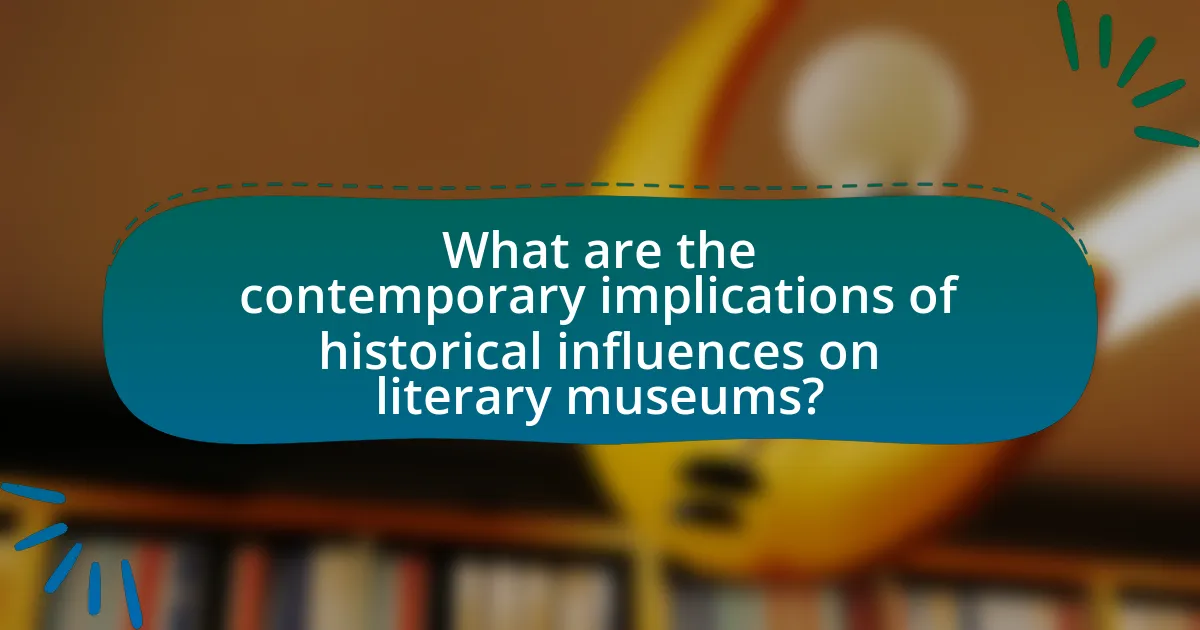
What are the contemporary implications of historical influences on literary museums?
Contemporary implications of historical influences on literary museums include the shaping of narratives that reflect cultural heritage and the promotion of literary tourism. Historical events, such as the establishment of national literatures and movements like Romanticism, have led museums to curate exhibits that highlight significant authors and their contributions, thereby fostering a deeper understanding of literary contexts. For instance, the rise of post-colonial literature has prompted museums to address previously marginalized voices, enhancing inclusivity and diversity in literary representation. This evolution not only attracts a broader audience but also encourages critical engagement with historical texts, as seen in the increasing number of interactive exhibits and educational programs that connect past literary movements to contemporary issues.
How do current events shape the evolution of literary museums?
Current events significantly influence the evolution of literary museums by prompting them to adapt their narratives and exhibits to reflect contemporary societal issues. For instance, the rise of movements such as Black Lives Matter has led many literary museums to reassess their collections and highlight works by marginalized authors, thereby fostering inclusivity and relevance. Additionally, the COVID-19 pandemic has accelerated the integration of digital technologies in literary museums, allowing for virtual tours and online programming that reach broader audiences. These adaptations demonstrate how literary museums respond to current events to remain pertinent and engaging, ensuring they reflect the dynamic cultural landscape.
What role do contemporary social movements play in the programming of literary museums?
Contemporary social movements significantly influence the programming of literary museums by shaping their narratives, exhibitions, and community engagement strategies. These movements advocate for representation and inclusivity, prompting museums to highlight diverse voices and perspectives that reflect current societal issues. For instance, movements focused on racial justice and gender equality have led literary museums to curate exhibits that feature underrepresented authors and themes, thereby fostering a more comprehensive understanding of literary history. This shift is evident in initiatives like the inclusion of LGBTQ+ literature in programming, which aligns with broader social movements advocating for LGBTQ+ rights. Such adaptations not only enhance the relevance of literary museums but also engage a wider audience, ensuring that these institutions remain vital cultural spaces that reflect contemporary values and concerns.
How are literary museums adapting to reflect current historical narratives?
Literary museums are adapting to reflect current historical narratives by incorporating diverse perspectives and contemporary issues into their exhibitions and programming. For instance, many museums are now showcasing works from underrepresented authors and addressing themes such as social justice, migration, and identity, which resonate with today’s societal challenges. This shift is evident in initiatives like the inclusion of interactive digital displays that allow visitors to engage with current events through the lens of literature, thereby contextualizing historical narratives within modern frameworks. Additionally, literary museums are collaborating with local communities and scholars to ensure that their exhibits reflect a broader range of voices and experiences, thus making the narratives more relevant and accessible to contemporary audiences.
What best practices can literary museums adopt to honor historical influences?
Literary museums can adopt several best practices to honor historical influences, including the integration of historical context into exhibitions, collaboration with historians and literary scholars, and the preservation of original manuscripts and artifacts. By providing detailed narratives that connect literary works to their historical backgrounds, museums can enhance visitor understanding of the cultural and social dynamics that shaped these texts. Collaborating with experts ensures that the interpretations presented are accurate and reflective of the time periods in question. Furthermore, preserving original manuscripts and artifacts allows museums to offer tangible connections to the past, enriching the visitor experience and fostering a deeper appreciation for the literary heritage.
How can museums engage with local communities to reflect historical narratives?
Museums can engage with local communities to reflect historical narratives by actively involving community members in the curation process. This can be achieved through collaborative exhibitions that incorporate local stories, artifacts, and oral histories, ensuring that the narratives presented are representative of the community’s diverse experiences. For instance, the Smithsonian Institution’s “Community Curation” initiative demonstrates how museums can empower local voices by allowing residents to contribute to exhibitions, thereby fostering a sense of ownership and relevance. Additionally, hosting workshops, lectures, and events that invite community participation can further enhance the connection between the museum and its local audience, making historical narratives more accessible and meaningful.
What strategies can be implemented to ensure diverse historical perspectives are represented?
To ensure diverse historical perspectives are represented, literary museums can implement strategies such as inclusive curatorial practices, community engagement initiatives, and collaborative exhibitions. Inclusive curatorial practices involve actively seeking out and incorporating narratives from underrepresented groups, ensuring that the museum’s collection reflects a wide range of experiences and viewpoints. Community engagement initiatives, such as workshops and public forums, allow museums to gather input from diverse audiences, fostering a sense of ownership and representation in the historical narratives presented. Collaborative exhibitions with local historians and cultural organizations can further enhance the representation of varied perspectives, as these partnerships can bring in expertise and resources that highlight different historical contexts. These strategies are supported by research indicating that museums that prioritize inclusivity not only attract a broader audience but also enrich the educational experience by presenting a more comprehensive view of history.
